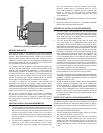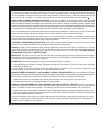
26
VENT AND AIR PIPE INSTALLATION
1. Measure from the boiler level to vent. Refer to the Table 14
on Page 36 for the allowable lengths.
2. Prepare pipes to the required lengths and deburr the inside
and outside of the pipe ends. Chamfer outside the pipe end
to ensure even cement distribution when joining.
3. Clean all pipe ends and ttings using a clean dry rag.
(Moisture will retard curing and dirt or grease will prevent
adhesion.)
4. Dry t vent or air piping to ensure proper t before assembling
any joint. The pipe should go a third to two-thirds into the
tting to ensure proper sealing after cement is applied.
5. Priming and Cementing:
• Handle pipes and ttings carefully to prevent
contamination of surfaces.
• Apply an even coat of primer to the tting socket.
• Apply an even coat of primer to the pipe end to
approximately 1/2" beyond the socket depth.
• Apply a second primer coat to the tting socket.
• While primer is still wet, apply an even coat of approved
cement to the pipe equal to the depth of the tting
socket.
• While primer is still wet, apply an even coat of approved
cement to the tting socket.
• Apply a second coat of cement to the pipe.
• While the cement is still wet, insert the pipe into the
tting, if possible twist the pipe a 1/4 turn as you insert it.
Note: If voids are present, sufcient cement was not applied and
joint could be defective.
• Clear excess cement from the joint removing ring or
beads as it will needlessly soften the pipe.
When a sidewall or vertical rooftop combustion air supply system
is disconnected for any reason, the air inlet pipe must be resealed
to ensure that combustion air will be free of contaminants and
supplied in proper volume.
Failure to properly seal all joints and seams may result in ue
gas recirculation, spillage of ue products and carbon monoxide
emissions causing severe personal injury or death.
AIR INLET PIPE MATERIALS
Make sure the air inlet pipe(s) are sealed. The acceptable air
inlet pipe materials are:
• PVC/CPVC
• AL 29-4C
An adapter is provided for transition between the air inlet
connection on the boiler and the plastic air inlet pipe.
Seal all joints and seams of the air inlet pipe using either
Aluminum Foil Duct Tape meeting UL Standard 723 or 181A-P or
a high quality UL Listed silicone sealant. Do not install seams of
vent pipe on the bottom of horizontal runs.
Secure all joints with a minimum of 3 sheet metal screws or pop
rivets. Apply Aluminum Foil Duct Tape or silicone sealant to all
screws or rivets installed in the vent pipe.
Make sure that the air inlet pipes are properly supported.
The PVC/ CPVC air inlet pipe must be cleaned and sealed with
the pipe manufacturer’s recommended solvents and standard
commercial pipe cement for the material used. The PVC, CPVC,
air inlet pipe should use a silicone sealant to ensure a proper seal
at the boiler connection and the air intake adapter connection.
Proper sealing of the air inlet pipe ensures that combustion air
will be free of contaminants and supplied in proper volume.
REQUIREMENTS FOR INSTALLATION IN CANADA
1. Installations must be made with a vent pipe system certied
to ULC-S636. IPEX is an approved vent manufacturer in
Canada supplying vent material listed to ULC-S636.
2. The initial 3 feet of plastic vent pipe from the appliance ue
outlet must be readily accessible for visual inspection.
3. The components of the certied vent system must not be
interchanged with other vent systems or unlisted pipe/
ttings.
FIGURE 22. PVC/CPVC VENTING WITH ADAPTER
FIGURE 23. PVC/CPVC VENTING - HORIZONTAL


















